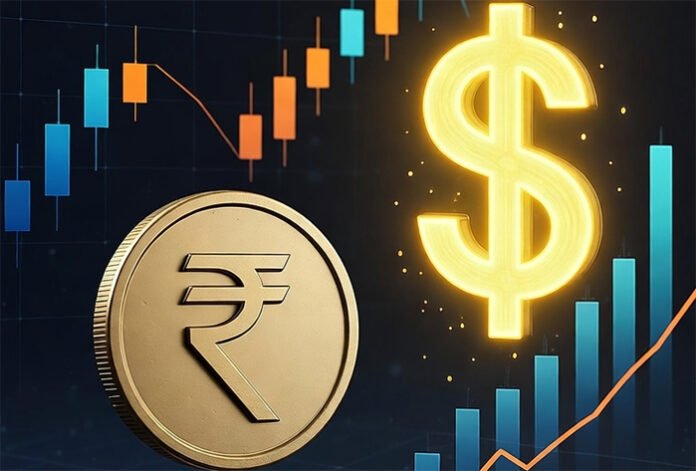New Delhi, October 29, 2025:
The Indian rupee continued its downward slide on Tuesday, closing at ₹88.29 per US dollar, its lowest level in two weeks. Traders attributed the decline to rising global crude oil prices, foreign fund outflows, and strength in the US dollar index.
In early trade, the rupee opened weak at ₹88.12 and touched a day’s low of ₹88.38 before recovering slightly by market close.
“Higher oil prices have pushed up dollar demand from oil importers, while FPIs are taking money off the table due to global risk aversion,” said Amit Goenka, Chief Economist at LKP Securities.
💹 Why Is the Rupee Falling Again?
The rupee’s latest fall isn’t random — it’s being hit from three sides: energy, equity, and external headwinds.
1️⃣ Crude Oil Shock:
Brent crude surged past $88 per barrel, raising India’s import bill.
India imports over 85% of its oil, so every $1 increase in crude costs the economy an additional ₹11,000 crore annually.
“This is a classic oil-dollar trap. As crude rises, the rupee weakens due to higher dollar demand,” explained Rohit Jain, Forex Strategist at Kotak Mahindra Bank.
2️⃣ Foreign Fund Outflows:
FPIs (Foreign Portfolio Investors) have withdrawn $430 million from Indian markets over the last week, shifting toward safer US treasuries amid renewed global uncertainty.
3️⃣ Dollar Dominance:
The US Dollar Index (DXY) rose to 107.4, strengthening against major global currencies, including the yen and euro, as investors priced in a “higher-for-longer” US interest rate outlook.
⚖️ RBI’s Response and Market View
The Reserve Bank of India (RBI) is believed to have intervened in the forex market to prevent excessive volatility. Dealers reported that the central bank sold dollars around ₹88.35 to cushion the slide.
“RBI is ensuring stability without defending a particular level. They’re managing volatility, not value,” said Sonal Varma, Chief Economist at Nomura India.
However, the RBI’s task is tricky — continuous intervention depletes foreign exchange reserves, which currently stand at $642.1 billion, down from $650 billion earlier this month.
💸 Impact on the Economy
A weaker rupee affects multiple layers of the economy — from trade to inflation.
Import Costs Rise: Crude oil, electronics, and machinery become costlier.
Inflation Pressure: Higher import bills can push up fuel and transport costs.
Export Advantage: Software and textile exporters may gain, as they earn in USD.
Debt Servicing: Companies with foreign currency loans face higher repayment costs.
“The rupee’s fall could push inflation slightly higher, but exports may offset some of the pain,” noted Rajesh Menon, Head of Research at SBI Capital.
🧭 Global Factors Behind the Slide
Middle East tensions have rattled energy markets.
China’s mixed economic data weakened Asian currencies.
US bond yields remain elevated near 4.8%, keeping the dollar strong.
“The global risk-off sentiment is pushing investors toward the dollar and gold,” said Aditi Shah, Currency Strategist at Axis Bank.
📊 How the Rupee Has Moved in 2025
| Month | Average Rate (USD/INR) | Key Driver |
|---|---|---|
| January | ₹82.50 | Fed tightening |
| April | ₹84.70 | Strong dollar |
| July | ₹86.10 | Oil rally |
| October | ₹88.29 | FPI outflows + Oil spike |
💼 What’s Next for the Rupee?
Experts expect the rupee to remain under mild pressure in the short term but stabilize around ₹87–₹88 levels by December, assuming oil prices cool.
“If Brent stays below $90 and FPIs return to Indian debt, we could see the rupee bounce back slightly,” said Jain.
However, any escalation in global tensions or further OPEC+ supply cuts could push the rupee closer to ₹89–₹90 per USD.
💬 What Should Investors Do?
Importers: Hedge near-term exposure.
Exporters: Benefit from current rates by booking forward contracts.
Retail Investors: Stay cautious on foreign travel and education costs.
“Currency moves impact everyone — from corporates to consumers. Staying informed helps minimize shocks,” said Varma.
🔍 A Wake-Up Call for India’s Economy
The rupee’s fall reflects not just global uncertainty but India’s sensitivity to external shocks.
As policymakers balance inflation and growth, the currency’s health remains a key indicator of economic stability.
“The rupee is not in crisis — it’s adjusting to global realities. But the next few weeks will test the RBI’s resolve,” concluded Goenka.
✅ Summary Highlights:
Rupee closed at ₹88.29/USD, lowest in 2 weeks.
Triggered by rising oil, FPI outflows, and strong dollar.
RBI intervening to smooth volatility.
Economists see stabilization near ₹87–₹88 by December.
Exporters gain; importers face higher costs.
















